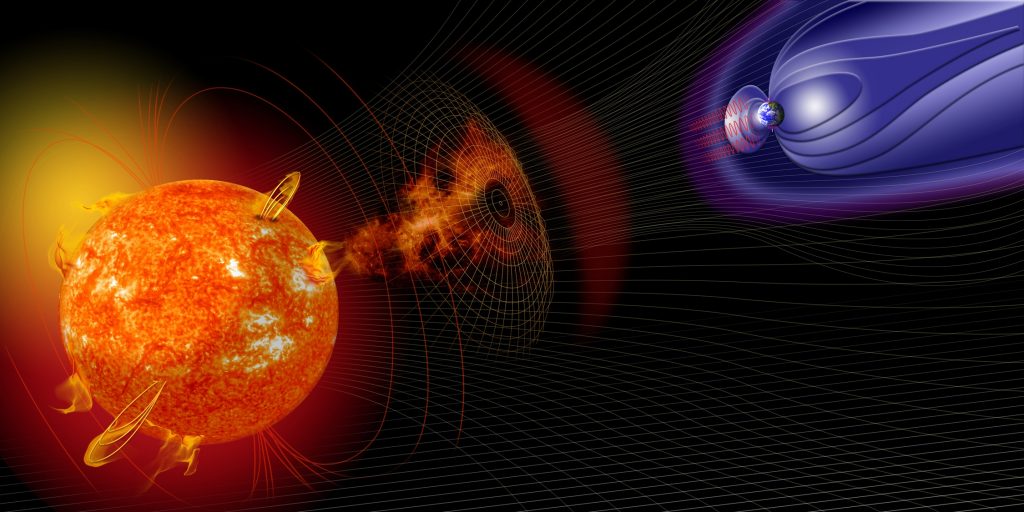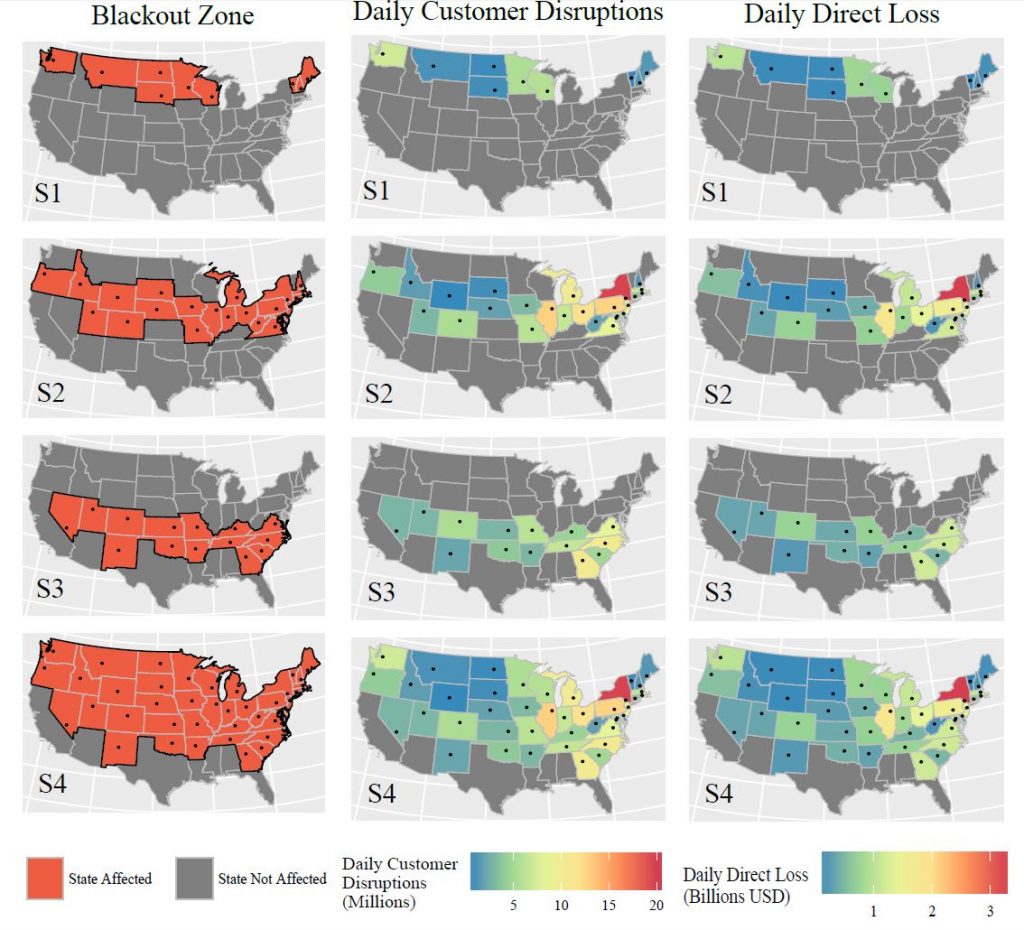New study finds more than half the loss occurs outside the blackout zone
18 January 2017
WASHINGTON, DC — The daily U.S. economic cost from solar storm-induced electricity blackouts could be in the tens of billions of dollars, with more than half the loss from indirect costs outside the blackout zone, according to a new study.

Artist illustration of events on the sun changing the conditions in Near-Earth space. A new study finds daily U.S. economic cost from solar storm-induced electricity blackouts could be in the tens of billions of dollars.
Credit: NASA.
Previous studies have focused on direct economic costs within the blackout zone, failing to take into account indirect domestic and international supply chain loss from extreme space weather.
“On average the direct economic cost incurred from disruption to electricity represents only 49 percent of the total potential macroeconomic cost,” says the paper published in Space Weather, a journal of the American Geophysical Union. The paper was co-authored by researchers from the Cambridge Centre for Risk Studies at University of Cambridge Judge Business School; British Antarctic Survey; British Geological Survey and University of Cape Town.
Under the study’s most extreme blackout scenario, affecting 66 percent of the U.S. population, the daily domestic economic loss could total $41.5 billion plus an additional $7 billion loss through the international supply chain.
Electrical engineering experts are divided on the possible severity of blackouts caused by “Coronal Mass Ejections,” or magnetic solar fields ejected during solar flares and other eruptions. Some believe that outages would last only hours or a few days because electrical collapse of the transmission system would protect electricity generating facilities, while others fear blackouts could last weeks or months because those transmission networks could in fact be knocked out and need replacement.
Extreme space weather events occur often, but only sometimes affecting Earth. The best-known geomagnetic storm affected Quebec in 1989, sparking the electrical collapse of the Hydro-Quebec power grid and causing a widespread blackout for about nine hours.
There was a very severe solar storm in 1859 known as the “Carrington event” (after the name of a British astronomer). A widely cited 2012 paper by Pete Riley of Predictive Sciences Inc. said that the probability of another Carrington event occurring within the next decade is around 12 percent; a 2013 report by insurer Lloyd’s, produced in collaboration with Atmospheric and Environmental Research, said that while the probability of an extreme solar storm is “relatively low at any given time, it is almost inevitable that one will occur eventually.”

This figure shows the blackout zone, daily customer disruptions and daily lost GDP according to different scenarios. The S1 scenario occurs at 55±2.75 degrees geomagnetic latitude affected 8 percent of the US population and caused a direct economic loss to the US economy of $3.2 billion per day (8 percent of daily US GDP). In the S2 scenario (50±2.75 degrees geomagnetic latitude) a considerable proportion of industrial production was affected, along with 44 percent of the population. The S3 scenario (45±2.75 degrees geomagnetic latitude) affected 23 percent of the US population leading to an economic loss of $16.5 billion per day (41 percent of daily US GDP). In the much larger S4 scenario (50±7.75 degrees geomagnetic latitude), 66 percent of the population were affected. This leads to an estimated potential economic loss of $41.5 billion per day to the US economy (100 percent of daily US GDP), combined with a daily loss to the global economy of $7 billion.
Credit: American Geophysical Union.
“We felt it was important to look at how extreme space weather may affect domestic U.S. production in various economic sectors, including manufacturing, government and finance, as well as the potential economic loss in other nations owing to supply chain linkages,” says study co-author Edward Oughton of the Cambridge Centre for Risk Studies at Cambridge Judge Business School. “It was surprising that there had been a lack of transparent research into these direct and indirect costs, given the uncertainty surrounding the vulnerability of electrical infrastructure to solar incidents.”
The study’s scope was guided by a July 2015 conference held at Cambridge Judge.
The study looks at three geographical scenarios for blackouts caused by extreme space weather, depending on the latitudes affected by different types of incidents.
If only extreme northern states are affected, with 8 percent of the U.S. population, the economic loss per day could reach $6.2 billion supplemented by an international supply chain loss of $0.8 billion. A scenario affecting 23 percent of the population could have a daily cost of $16.5 billion plus $2.2 billion internationally, while a scenario affecting 44 percent of the population could have a daily cost of $37.7 billion in the US plus $4.8 billion globally. (The study is calculated using 2011 U.S. dollars.)
Manufacturing is the U.S. economic sector most affected by those solar-induced blackouts, followed by government, finance and insurance, and property. Outside of the U.S., China would be most affected by the indirect cost of such U.S. blackouts, followed by Canada and Mexico – as “these countries provide a greater proportion of raw materials, and intermediate goods and services, used in production by U.S. firms.”
###
The American Geophysical Union is dedicated to advancing the Earth and space sciences for the benefit of humanity through its scholarly publications, conferences, and outreach programs. AGU is a not-for-profit, professional, scientific organization representing 60,000 members in 137 countries. Join the conversation on Facebook, Twitter, YouTube, and our other social media channels.
Notes for Journalists
This research article is open access for 30 days. A PDF copy of the article can be downloaded at the following link: http://onlinelibrary.wiley.com/doi/10.1002/2016SW001491/pdf.
After 30 days, journalists and public information officers (PIOs) of educational and scientific institutions who have registered with AGU can download a PDF copy of the article from the same link.
Journalists and PIOs may also order a copy of the final paper by emailing a request to Lauren Lipuma at [email protected].
Please provide your name, the name of your publication, and your phone number.
Neither the paper nor this press release is under embargo.
“Quantifying the daily economic impact of extreme space weather due to failure in electricity transmission infrastructure”
Authors:
Edward J. Oughton: Centre for Risk Studies, Judge Business School, University of Cambridge, Cambridge, England;
Andrew Skelton: Centre for Risk Studies, Judge Business School, University of Cambridge, Cambridge, England;
Richard B. Horne: British Antarctic Survey, Natural Environment Research Council, Cambridge, England
Alan W. P. Thomson: British Geological Survey, Natural Environment Research Council, Edinburgh, Scotland;
Charles T. Gaunt: University of Cape Town, Rondebosch, Cape Town, South Africa.
Contact information for the authors:
Edward Oughton: [email protected], +44(0) 7920 401571.
Lauren Lipuma
+1 (202) 777-7396
[email protected]
University of Cambridge Contact:
Charles Goldsmith
+44 (0)1223 339608
[email protected]
British Antarctic Survey Contact:
Athena Dinar
+44 1223 221441
[email protected]